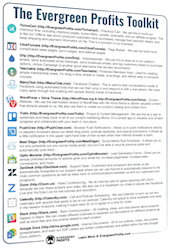[av_textblock size=” font_color=” color=” av-medium-font-size=” av-small-font-size=” av-mini-font-size=” custom_class=” admin_preview_bg=”]
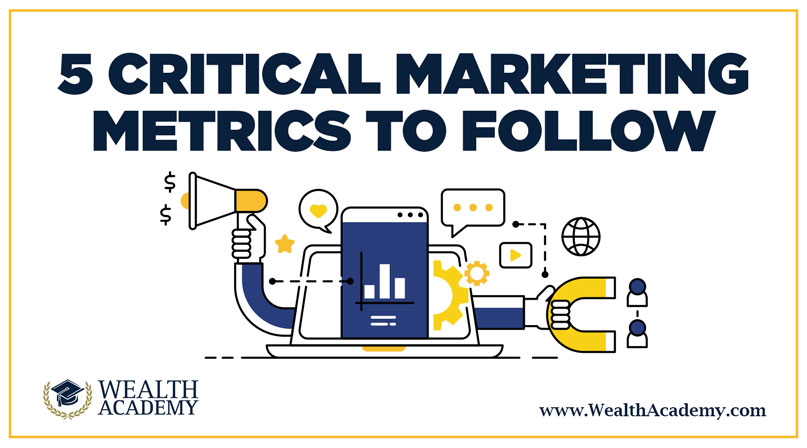
5 Marketing Metrics Businesses Must Follow
Let’s look at some quick marketing metrics every entrepreneur should follow.
Marketing metrics are the foundation for any successful marketing strategy. Still, most companies fail to use many of these important metrics to calculate success or failure. Too often, companies focus heavily on the number of new leads generated. However, this approach ignores many of the complex formulas that can determine the true success of any marketing strategy.
Marketers are in a revolving cycle of constant change and flux. With the increasing number of marketing options and strategies, companies and marketers need to stay ahead of their competition. To help formulate an effective strategy, it is imperative that you understand these critical marketing metrics and their formulas.
ROI (Return on Investment).
ROI is the most common formula and probably the easiest to understand. It is a measurement tool used to calculate the effectiveness and value of an investment. It shows the gain or loss of an investment, by comparing and measuring the amount of return on that investment with its costs.
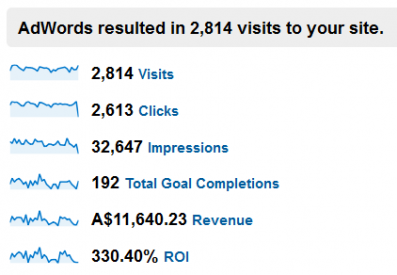
ROI is popularly used in tandem with other methods to help develop crucial business plans based on the metrics received. However, ROI calculations can be adjusted and manipulated for different uses.
One company may use it to evaluate a return on a stock. Another may use it to make vital decisions on whether the new PPC or SEO strategy is effective.
For example, a company makes an investment of $5,000 into Google AdWords and generates $10,000 in net profit. The formula would look like this: ROI = (Net Profit / Cost of Investment) x 100.
Divide the profit from an investment by the cost, and the result is a percentage. In this case, ROI = Profit ($10,000 – $5,000) divided by cost (/$5,000) X 100. The result is a 100% ROI.
CPA (Cost Per Action).
CPA is referred to as Cost Per Acquisition, Pay Per Action or Cost Per Action. This marketing metric is a formula that measures the amount a business has paid to attain a conversion. CPA is also used to define a marketing strategy which allows advertisers to pay for a specified action from potential consumers, such as making a purchase or filling out a form. CPA campaigns are relatively low-risk, as costs are only accumulated once the desired action has occurred.
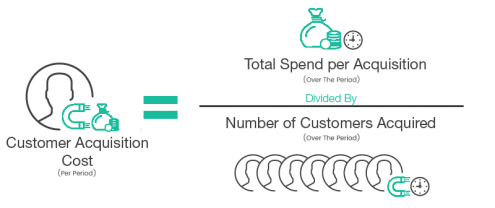
Most companies define CPA as Cost per Acquisition. For example, a company invests $1,000 in an SEO campaign. They receive 100 new customers specifically from SEO. Their CPA is $10 per customer. The formula is CPA = (Cost/ Conversions). Simply divide the cost of the ad campaign by the conversions.
ROAS (Return On Advertising Spend).
Simply put, ROAS is a tool to measure the profit made from advertising. It’s the most useful metric to evaluate the performance of marketing campaigns, as it measures how much revenue you get back on each dollar spent on advertising. While ROI can give you an overall view, using ROAS formulas allows you to gain specific performance measurements based on every marketing network executed. For example, you can apply ROAS to specific campaigns and ad groups. This allows you to gain a better perspective on the best direction for optimizing unprofitable advertising.
ROAS calculations will also tell you, at the most fundamental level, if your marketing channel is performing at a high enough level. This will help you determine just how profitable the channel is for your business. For example, a company spends $20,000 on Google Ads and received $60,000 in revenue.
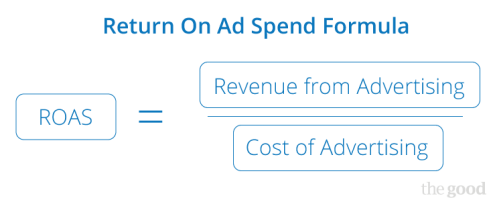
The ROAS formula is super simple. ROAS = (Ad revenue/ Cost of ad source). Just divide the revenue generated from an advertisement by its cost. In this case, it would be $3 – ($60,000/$20,000). In other words, for every dollar spent, the company makes $3 in revenue.
CLV (Customer Lifetime Value).
The Customer Lifetime Value metric is used to determine the economic value a customer brings to your business. This counts for the entire time they remain a customer. This metric considers everything from their first interaction to their final purchase. This is essential to determine if there is more value in long-term marketing channels.
If your CLV value is high from a specific marketing channel, you’ll want to invest more into retaining these customers. Assuming you have a positive ROI, of course. This marketing metric also allows you to evaluate your company’s success based on the long-term results of your marketing strategies.
For example, if you fill 600 orders and gain $40,000 in revenue, your average order value would be $66.67. Then, you can determine the purchase frequency (PF) by dividing the number of orders by the unique customers. In this case, if you had 400 unique customers, the PF would be 1.5. To calculate your Customer Value (CV), you multiply these numbers. In this case, it would be 66.67 (AOV) x 1.5 (PF) = $100 (CV).
Now, to determine the Customer Lifetime Value, you take the CV and multiply it by the customer’s duration with your company. Generally, choosing a number between one and five provides accurate results, so let’s assume each order also comes with a contract. Let’s assume a 3-year contract is your minimum.

Your formula would look like this: 100 (CV) x 3 (Years) = $300. Your customer’s lifetime value is $300 over a course of three years.
The Customer Lifetime Value (CLV) formula:
AOV = (Number of Orders X Revenue)
PF = (Average Order Value / Number of Unique Customers)
CV = (Average Order Value X PF)
CLV = Customer Value X Customer’s Duration with the Company
Customer Retention Rate.
Customer Retention Rate is a marketing metric used to calculate how loyal your customers are. Acquiring a new customer costs more than retaining current ones. Determining how dedicated a customer is to your company allows you to improve your business strategies. If you can encourage loyal customers to stay with your business longer, you’ll maximize your revenue.
For example, let’s say you start a quarter with 25 customers (CS) and gain 10 new customers (CN). However, you also lose seven in that quarter. The number of customers at the end of the period (CE) would be 28. Using the following formula, you can then determine what your Customer Retention Rate is, which in this case would be 72 percent.
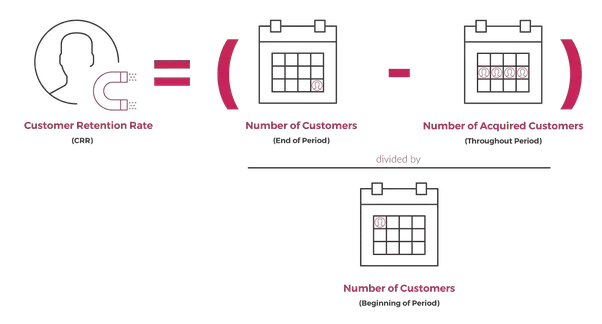
The formula to use for Customer Retention Rates = (Customer’s End Period – New Customers for this Period) / Customers at Start of the Period x 100. Subtract the new customers from the number of customers at the period’s end, and divide that by the customers at the start of the period. Then, simply multiply it by 100 to get the percentage of Customer Retention.
Bonus Material.
Money metrics vs marketing metrics – Turning your ads into profits – Building 6 different million dollar lifestyle brands at age 27 – PLUS – 3 magical questions and 1 proven formula that drive “scaling up”.
Final Thoughts On Marketing Metrics
I’m confident that, if you follow these Quick Marketing Metrics outlined in this article, you’ll be able to start leveraging your marketing efforts and make big bucks.
These metrics gives you tremendous potential. Once implemented, it will enable you to quickly grow your business and scale your profits to that 6 figures income you dream off!
Need help implementing these “Marketing Metrics”? want to learn what it really takes to build a wildly profitable online business in today’s marketplace?
Get the knowledge you need to start, grow and scale a profitable online business directly from an internet millionaire & his rockstar team! Register for Max Income System here <
This is a comprehensive, step-by-step course designed systematically to help you build and run a sustainable & lucrative online business.
With this revolutionary course, you’ll be able to leverage the power of “marketing metrics” and reliably generate $10,000+ a month with your business.
So, if you’re struggling to generate leads, drive sales, and scale your profits, or want to start a successful online business from scratch – Register for Max Income System here <
Best of luck in all your business endeavors.
About The Author:
Your Millionaire Mentor
Shaqir Hussyin

Shaqir Hussyin is the founder and CEO of WealthAcademy.com & Funnels.com. Nicknamed the “Backpack Millionaire”, he has invested $350,000 into his own education and training. Whilst traveling to 100+ countries, Shaqir has built over 10+ million dollar brands and attracted over 500,000+ subscribers.
His signature program is now available: Max Income System; 14 Simple Steps To Making Your First Income Online
Shaqir is also a highly sought-after speaker and direct response “Sales Funnels” global leader whose work has impacted over 100,000 businesses in 65 different countries. Connect with Shaqir on Instagram, YouTube, LinkedIn & FB Group..
[/av_textblock]







